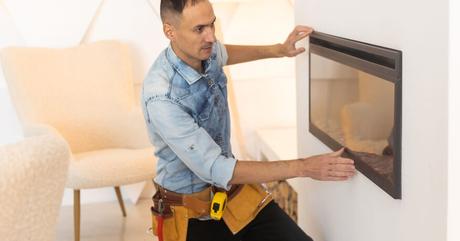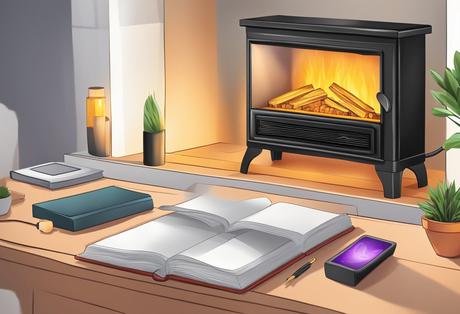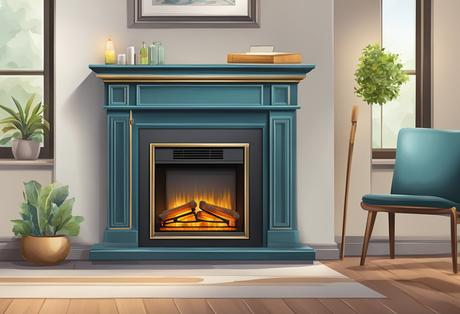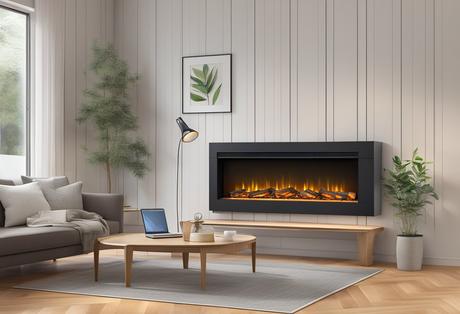Welcome to our comprehensive guide on "Electric Fireplace Troubleshooting and Maintenance." If you're facing challenges with your electric fireplace, ranging from simple operational glitches to more complex technical issues, this guide is tailored for you.
With over 7 years of experience in home automation and appliance maintenance, we've helped numerous homeowners navigate the complexities of electric fireplace upkeep and have rigorously tested our recommendations in real-world settings.
In this blog, we'll walk you through the essentials of diagnosing and resolving common electric fireplace problems, from addressing power and heating element issues to ensuring proper ventilation and control settings.
Our goal is to provide you with practical, experience-backed information that will help you solve your electric fireplace problems.
Key Takeaways
- Troubleshooting Steps: Encounter a problem? Our guide outlines systematic steps to diagnose and resolve common issues, from power and heating element troubles to blower and lighting malfunctions.
- Routine Maintenance: Keep your electric fireplace in top shape with our maintenance tips. Regular cleaning, proper clearance, and part replacements are key to longevity and efficiency.
- Safety Protocols: Your safety is paramount. Always turn off and unplug your fireplace before beginning any maintenance or troubleshooting tasks.
- Exploring Advanced Features: Learn about the advanced functionalities of modern electric fireplaces, including remote control operations and innovative infrared heating technology.
- When to Seek Help: Unsure about a technical issue? Our guide indicates when to refer to the user manual, contact customer support, or seek professional assistance for more complex electrical concerns.
Getting Started with Your Electric Fireplace

When you encounter issues with your electric fireplace, a systematic approach can save you time and ensure a safe environment for troubleshooting.
Understanding the basic operation and necessary preparations will enable you to diagnose problems effectively.
Understanding Your Electric Fireplace
Your electric fireplace is designed to mimic the look and feel of a traditional fireplace without the need for wood or gas. It uses electrical components to generate heat and simulate flames. Every model comes with a user manual, which is an essential resource for specifications and operating instructions.
Ensure you're familiar with the manual's content, as it can be invaluable for troubleshooting.
Preparation Before Diagnosis
Before attempting any diagnosis, verify that your fireplace is correctly installed and the power cord is securely plugged into an outlet. If you recently moved or just installed your electric fireplace, double-check all connections.
Also, try a simple reset by turning the unit off and back on again.
Safety First: Turning Off and Unplugging
Whenever you're about to diagnose an issue, prioritize safety. Always turn off your electric fireplace at the switch and unplug it from the power source.
This step prevents any electrical hazards while you examine components or attempt any fixes.
Once you've ensured the unit is safe to touch, you can start your troubleshooting process with confidence.
Troubleshooting Steps for Common Electric Fireplace Issues
When your electric fireplace runs into trouble, a systematic approach will help pinpoint the issue. These steps guide you through resolving the most common problems.
Assessing Power and Electrical Connections
Before diving deeper, ensure your unit is receiving power. Verify that the fireplace is securely plugged into the outlet and it's not controlled by a wall switch that's turned off. For hardwired models, check the corresponding circuit breaker hasn't tripped. If a fuse is blown, replacing it might readily solve the power issue.
Examining Heating Elements and Thermostat
If your fireplace powers up but there's no heat, the heating elements or thermostat may be at fault. Check if the thermostat is set correctly; it should be higher than the room temperature. For a malfunctioning thermostat, consult your user's manual on how to reset it.
A persistent issue might mean you'll have to replace the heating element or thermostat.
Inspecting the Blower and Ventilation
A blower fan that's stopped working could prevent heat from spreading. Peek into the fireplace to see if there's any visible blockage around the blower.
You should also confirm if the ventilation isn't obstructed. Press the reset button if your model has one, as it can sometimes restore the blower's function.
Checking Flames and Lighting Features
No flames? It's possible the bulb or LED that creates the fire effect requires replacement.
If the flames are on but look incorrect, it might be a settings problem. Use your remote control to adjust the flame settings, or reset the fireplace to default, which can correct many small glitches.
Ensuring Proper Control and Settings
Lastly, if the fireplace isn't responding to commands, it may be a control issue. Make sure the remote control has functional batteries and isn't the source of the problem. For a switch malfunction, check the wiring and control board. These can be complex, so consider professional help if you're not comfortable with electrical components.
Maintenance and Care
Taking good care of your electric fireplace ensures it operates efficiently and lasts longer. Regular maintenance can prevent the majority of issues before they arise.
Routine Cleaning and Dusting
To keep your electric fireplace working smoothly, clean it regularly to avoid dust and debris build-up. Start by switching off and unplugging your fireplace, then use a soft cloth or microfiber to gently wipe the exterior.
Open the front glass panel, if possible, and carefully remove any accumulated dust inside with a cloth or a soft brush.
Verifying Clearances and Placement
Your electric fireplace needs proper clearance to ensure safety and adequate air circulation. Check the manufacturer's recommendations for the correct distance from combustible materials.
Make certain there's enough space around the vents to prevent overheating and to allow for effective heat distribution.
Inspecting and Replacing Parts as Necessary
Over time, components like bulbs or filters in your electric fireplace may wear out. Inspect them periodically, looking for signs of damage or deterioration.
Should a part require replacement, refer to your user manual and purchase official components to guarantee compatibility and safety.
Technical Issues and Professional Help
When your electric fireplace acts up, knowing how to address technical issues can save you time and stress. A proper assessment of wiring and connections is crucial, as is leveraging the user manual and customer support. If these steps don't resolve the issue, it may be time to call in a professional electrician.
Identifying Wiring and Connection Problems
First, check your fireplace's power cord and ensure it's firmly plugged into the outlet. Look for any visible signs of wear or damage on the cord. Then, inspect the internal wiring if accessible, being careful not to tamper with complex components beyond basic troubleshooting.
Consulting the User Manual and Customer Support
Your electric fireplace's user manual is a treasure trove of solutions. Refer to it for specific troubleshooting tips related to your model. If the manual doesn't solve your dilemma, don't hesitate to contact customer support for expert guidance.
When to Contact an Electrician
Should your fireplace still refuse to cooperate, it's wise to consult a licensed electrician. Electrical appliances like these sometimes encounter complex issues only a professional should handle, especially when electricity is involved to prevent any safety hazards.
Addressing Less Common Issues
When tackling less common issues with your electric fireplace, you'll need to consider factors like overheating due to improper placement, malfunctioning electronic components, and issues with the power source.
Let's dive into each problem and find a solution.

Resolving Overheating and Incorrect Placement
Your electric fireplace may overheat if it's not placed in an appropriate location.
Ensure there's adequate clearance around the uni t, as this allows for proper air circulation. Keep it away from flammable materials and don't block the vents.
Dealing with Defective Electronic Components
It's possible that faulty electronic parts are causing trouble. If your fireplace isn't operating properly, inspect components such as the thermostat and heating element.
Contact customer support for specific parts replacement guidance if necessary.
Fixing Damaged Power Sources
If your fireplace won't power on, the issue could be with a damaged power source.
Make sure the power cord is firmly plugged in and check for any visible signs of wear or damage.
You should also inspect the fuse or circuit breaker associated with the outlet.
Prevention and Ongoing Care

To keep your electric fireplace running smoothly and to enhance its performance, it's vital to focus on routine maintenance and component upgrades. A well-cared-for fireplace not only operates efficiently but also establishes a warm and secure environment in your home.
Regular Maintenance Schedules
Monthly Inspections: Atleast once a month, you should examine your electric fireplace to ensure it's free of dust and debris. It's simple:
- Turn off and unplug your fireplace.
- Vacuum any loose particles with a gentle brush attachment.
- Wipe down the interior elements with a soft, dry cloth.
By keeping the coils clean, you'll prevent any unnecessary strain and maintain a cozy atmosphere.
Upgrading Components for Efficiency
Annual Reviews: Yearly, take the time to consider if any parts of your fireplace could benefit from an upgrade. Here's what to keep an eye on:
- Heating Elements: Over time, your fireplace's coil may wear down. Replacing old coils can keep your heater running at top efficiency.
- Blower Fan: Ensure it's in good shape to distribute heat properly and keep your space toasty.
These upgrades help in reducing electricity consumption while enhancing the warmth provided.
Creating a Cozy and Safe Fireplace Experience
Safety First: Never compromise on the safety aspect of your fireplace experience. Use this checklist for a secure setup:
- Proper Installation: Guarantee that your fireplace is positioned far from flammable materials.
- Surrounding Space: Keep at least 3 feet of clearance around the fireplace to prevent overheating and ensure good air circulation.
- Electrical Safety: Regularly check that the plug and outlet are functioning correctly; this is crucial for your appliance's safety.
Adhering to these suggestions will not only extend the life span of your electric fireplace but will also help you enjoy the warmth and ambiance without any worry.
Frequently Asked Questions

Encountering issues with your electric fireplace can be frustrating. This guide aims to address your major concerns with simple troubleshooting steps.
What are the steps to troubleshoot an electric fireplace that won't turn on?
To address an electric fireplace that won't power up, first ensure the unit is plugged into an electrical outlet and receiving power. If that checks out, examine the remote control for dead batteries and inspect any switches or dials on the fireplace itself. If it still won't turn on, check for a tripped breaker or blown fuse.
How can I fix an electric fireplace that is turning off unexpectedly?
If your fireplace shuts off by itself, it might be due to overheating. Clean any vents and fans to remove dust build-up, which allows for proper air circulation. You should also check that the thermostat is set correctly and not triggering an automatic shut-off sooner than desired.
What should I check if my electric fireplace has lights but isn't producing heat?
Check to ensure the heating element isn't disabled. Sometimes electric fireplaces have settings that allow for visuals with no heat. If the heat setting is correct, it might be a malfunctioning heating element or a problematic thermostat that needs inspection.
How can I replace the LED lights in my electric fireplace insert?
Replacing LED lights typically involves removing the access panel on your fireplace insert. Carefully locate the LED bulbs and disconnect them. You can then install new bulbs, ensuring they are the correct model and securely in place before reassembling the unit.
What could be the reason for the flame effect not working in my Dimplex electric fireplace?
For a malfunctioning flame effect in a Dimplex model, the issue could be with the motor or the bulb that creates the illusion. You can consult your manual to safely access these parts. Replace any burned-out bulbs or clear obstructions that may be hindering the motor's movement.
Is there a fuse in electric fireplaces that I should inspect if it's not working properly?
Yes, electric fireplaces often have a fuse that safeguards against surges. Locate your user manual for guidance on finding and inspecting the fuse. If you discover a blown fuse, replace it with an identical one as specified by the manufacturer.
